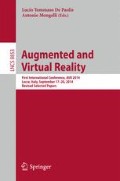Abstract
Personnel Training is considered as the most important prerequisite in the assembly operations of any kind of equipment/apparatus ranging from simple nut-bolt assembly to complex equipment (e.g., aircraft engine) assembly. This paper presents a novel Virtual Reality Training System (VRTS) for the constraint based assembly of a 3phase step down transformer. The ARToolKit [1] markers are used for interaction with the VRTS. The system improves the technical skills of students in the real assembly environment. The analysis shows that the average success rate of untrained students is 35.7% while that of trained students increased to 81.5%.
Access this chapter
Tax calculation will be finalised at checkout
Purchases are for personal use only
Preview
Unable to display preview. Download preview PDF.
References
Kato, H.: How does ARToolKit work?, ARToolKit Documentation (2/4/14). http://www.hitl.washington.edu/artoolkit/documentation/userarwork.htm
Mikropoulos, T.A., Natsis, A.: Educational virtual environments: A ten-year review of empirical research (1999–2009). Computers & Education 56, 769–780 (2011)
Jou, M., Wang, J.: Investigation of effects of virtual reality environments on learning performance of technical skills. Comput. Hum. Behav. 29, 433–438 (2013)
Mantovani, F., Castelnuovo, G., Gaggioli, A., Riva, G.: Virtual reality training for health-care professionals. CyberPsychology & Behavior 6, 389–395 (2003)
Riva, G.: Applications of virtual environments in medicine. Methods of Information in Medicine 42, 524–534 (2003)
Merchant, Z., Goetz, E.T., Cifuentes, L., Keeney-Kennicutt, W., Davis, T.J.: Effectiveness of virtual reality-based instruction on students’ learning outcomes in K-12 and higher education: A meta-analysis. Computers & Education 70, 29–40 (2014)
Chen, C.J., Toh, S.C., Ismail, W.M.F.W.: Are learning styles relevant to virtual reality? Journal of Research on Technology in Education 38, 123–141 (2005)
Wong, B., Ng, B., Clark, S.: Assessing the effectiveness of animation and virtual reality in teaching operative dentistry. Journal of Dentistry 1 (2000)
Heilig, M.: Sensorama simulator. united state patent office (3,050,870) (Patented August 28, 1962)
Hawkins, D.G.: Virtual reality and passive simulators: the future of fun. L. Erlbaum Associates Inc., Hillsdale (1995)
Youngblut, C.: Educational uses of virtual reality technology. IDA Document D-2128, i.o. d. analysis, ed., Alexandria (1998)
Ng, F.M., Ritchie, J.M., Simmons, J.E.L., Dewar, R.G.: Designing cable harness assemblies in virtual environments. Journal of Materials Processing Technology 107, 37–43 (2000)
Angelov, A.N., Styczynski, Z.A.: Computer-aided 3D Virtual Training in Power System Education. In: Power Engineering Society General Meeting, pp. 1–4. IEEE (2007)
Wang, Y., Cui, S., Yang, Y., Lian, J.-a.: Virtual Reality Mathematic Learning Module for Engineering Students. Technology Interface Journal 10 (Fall 2009)
Pasqualotti, A., Freitas, C.M.S.: MAT3D: A Virtual Reality Modeling Language Environment for the Teaching and Learning of Mathematics. CyberPsychology & Behavior 5, 409–422 (2002)
Savage, C., McGrath, D., McIntyre, T., Wegener, M., Williamson, M.: Teaching Physics Using Virtual Reality. In: American Institute of Physics Conference Series, pp. 126–129 (2010)
Kaufmann, H., Meyer, B.: Simulating educational physical experiments in augmented reality. In: SIGGRAPH Asia 2008 ACM SIGGRAPH ASIA 2008 Educators Programme. ACM (2008)
Dede, C., Salzman, M.C., Loftin, R.B., Sprague, D.: Multisensory Immersion as a Modeling Environment for Learning Complex Scientific Concepts. In: Feurzeig, W., Roberts, N., (eds.) Modeling and Simulation in Science and Mathematics Education Modeling Dynamic Systems, pp. 282–319. Springer, New York (1999)
Loftin, R., Bowen, M.E., Benedetti, R.: Applying virtual reality in education: A prototypical virtual physics laboratory. In: Proceedings of the IEEE 1993 Symposium on Research Frontiers in Virtual Reality, pp. 67–74. IEEE Computer Society Press (1993)
Crosier, J.K., Cobb, S.V.G., Wilson, J.R.: Experimental comparison of virtual reality with traditional teaching methods for teaching radioactivity. Education and Information Technologies 5, 329–343 (2000)
Zhang, Y., Travis, A.R.L., Collings, N.: Evaluation of Multi-sensory Feedback on the Usability of a Virtual Assembly Environment. Journal of Multimedia 2 (February 2007)
Yao, Y.X., Xia, P.J., Liu, J.S., Li, J.G.: A pragmatic system to support interactive assembly planning and training in an immersive virtual environment (I-VAPTS). Int J Adv Manuf Technol 30, 959–967 (2006)
Bryson, S.: Virtual Reality in Scientific Visualization. Communications of the ACM 39(5) (1996)
Dunne, C.J.R., McDonald, C.L.: Pulse!!: A Model for Research and Development of Virtual-Reality Learning in Military Medical Education and Training MILITARY MEDICINE 175 (July Supplement 2010)
Huang, H.-M., Liaw, S.-S., Lai, C.-M.: Exploring learner acceptance of the use of virtual reality in medical education: a case study of desktop and projection-based display systems, Interactive Learning Environments. Interactive Learning Environments (2013)
Nicholson, D.T., Chalk, C., Funnell, W.R.J., Daniel, S.J.: Can virtual reality improve anatomy education? A randomised controlled study of a computer-generated three-dimensional anatomical ear model. US National Library of Medicine National Institutes of Health 40, 1081–1087 (2006)
Mikropoulos, T.A., Katsikis, A., Nikolou, E., Tsakalis, P.: Virtual environments in biology teaching. Journal of Biological Education 37, 176–181 (2003)
Shima, Kew-Cheol: J.-S.P., Hyun-Sup Kima, Jae-Hyun Kima, Young-Chul Parka, Hai-Il Ryua Application of virtual reality technology in biology education. Journal of Biological Education 37, 71–74 (2003)
Bakasa, C., Mikropoulos, T.: Design of virtual environments for the comprehension of planetary phenomena based on students ideas. International Journal of Science Education 25, 949–967 (2003)
Hornecker, E., Psik, T.: Using ARToolKit Markers to Build Tangible Prototypes and Simulate Other Technologies. In: Costabile, M.F., Paternó, F. (eds.) INTERACT 2005. LNCS, vol. 3585, pp. 30–42. Springer, Heidelberg (2005)
Author information
Authors and Affiliations
Corresponding author
Editor information
Editors and Affiliations
Rights and permissions
Copyright information
© 2014 Springer International Publishing Switzerland
About this paper
Cite this paper
Rehman, I.U., Ullah, S., Rabbi, I. (2014). Measuring the Student’s Success Rate Using a Constraint Based Multi-modal Virtual Assembly Environment. In: De Paolis, L., Mongelli, A. (eds) Augmented and Virtual Reality. AVR 2014. Lecture Notes in Computer Science(), vol 8853. Springer, Cham. https://doi.org/10.1007/978-3-319-13969-2_4
Download citation
DOI: https://doi.org/10.1007/978-3-319-13969-2_4
Published:
Publisher Name: Springer, Cham
Print ISBN: 978-3-319-13968-5
Online ISBN: 978-3-319-13969-2
eBook Packages: Computer ScienceComputer Science (R0)

